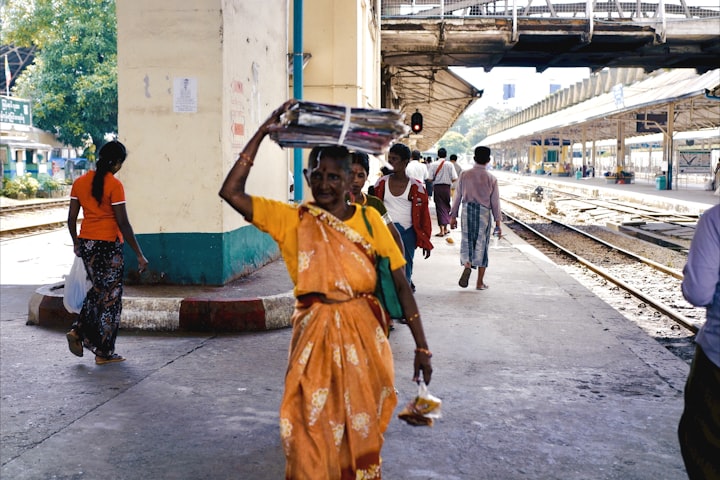The topic of tribal women is often ignored while talking about discrimination faced by marginalized women, despite them being an equal victim of the system. Moreover, tribal women’s resistance has generally occurred quite autonomously from urban feminist movements.
This article deals with several major issues faced by tribal women in India as well as their struggles against oppression in order to consolidate the elements and resources that would help tribal women in their struggle for gender justice at all walks of life.
In order to do so, the position of tribal women in comparison to tribal men as well as their non-tribal counterpart needs to be taken into consideration. The problems can be further classified into the following categories
Problems related to the economy

With the shifting nature of the economy and increasing industrialization and modernization, women are losing their traditional occupations.
For example, weaving is a traditional occupation of women in the North-East. Similarly, traditional weaves and glasswork are common among tribal women in Gujarat and Rajasthan.
Yet, with growing commercialization, the women’s indigenous designs are not so much in vogue, as the market demands diverse options in the quality of goods, design, color, and style.
In addition, the government has tied up with multimillion-dollar companies for the marketing and selling of tribal goods which gives tribal women a very small percentage of the market price of the goods produced by them, which is otherwise quite high.
Hence, they are being exploited due to a lack of bargaining strategies and access to the market.
Another major issue that exists is forced migration due to economic reasons (push and pull factors) which displays the classic example of how tribals are now being forced out of their natural habitats and are migrating outside to look for livelihood opportunities.
Tribal women are seen as different from others due to their inability to imbibe and adjust to dominant cultural attributes, which puts them at a disadvantageous position in non-tribal areas.
Thus, the increasing examples of atrocities and violence towards tribal women have characterized the growth trajectory of the neoliberal regime and exposed the loopholes of the inclusive development model (Rangarajan, 2012).
Coming to wages, despite their contribution to the area of agriculture, etc. tribal women are paid either nothing or even if they are paid, it is much lesser as compared to tribal men, revealing glaring discrimination and exploitation prevalent at a country level.
Hence, Dr. Lalrindiki (2013) strongly asserts, the fact that the wages of women being lower than the wages of men reveals the low status relegated to women in all spheres of life.
Besides, the tribal women are often forced to cater to the sexual needs of the contractors, agents, and even their co-male workers.
The flesh trade of the tribal women is increasing in recent times as their conditions are worsening (Sharma & Mittal, 1998). Thus, the expectation that industrialization coupled with the welfare measures would work wonders in the upliftment of the tribals has proved so far to be an illusion.
The biggest sufferers are the tribal women who have been exploited economically, mentally, and physically not only because they belong to the tribal community, but because they are “only women.”
Problems related to social structure

Coming to Descent, Inheritance, and Succession, often in Indian society, it is the male who gets the property and continues the family name. The authority is also vested in the hands of a male in the family.
In such a patrilineal society, tribal women tend to inherit movable property and the men get all the immovable property.
In the instances of Khasis, Garos, and Jaintia tribes of Meghalaya and Nayars of Kerala, there exists a matrilineal kind of social structure. Despite this, the power of actual management lies in the hand of the male members of the family. A daughter cannot sell the family property without the knowledge and consent of the uncles and brothers (Dianghunmon, 2009).
Thus, one needs to understand that matriliny is not equivalent to matriarchy, which refers to power in the hands of women.
In marriages and divorce, several tribal women enjoy certain freedom (Kumar, 1973).
For instance, Garasia women have the option of running away if forced to marry and securing the divorce later.
Similarly, for Maria Gonds, they can enjoy pre-marital sex and choose their own husband and divorce if he is unable to give her a child (Mann, 1987).
However, the fact remains that the men still hold vast power over women in households. They still have the final say in women’s decisions regarding their partner (Sharma & Mittal, 1998).
In addition, laws are quite negative towards women with regard to child custody, property rights, and alimony given by the husband.
There also exists ‘Bride price’ that is paid as compensation to the girl’s father and lead to several calling this as ‘marriage by purchase’ and thus women being seen as objects to be sold and bought.
Problems in the political sphere

When we are looking at the position of tribal women in the traditional political structure, they often are side-lined.
Every head of a community is generally a male who is usually honored, obeyed, and accepted as the head of the group. It is hereditary and the final authority is vested in him.
For instance, amongst the Aos tribe of Nagaland, all the decisions in the village are made by elders in the council.
In the Arunachal Pradesh tribe Padam Minyong, a woman is not allowed to join kebang which takes major decisions (Sharma & Mittal, 1998). Even in the case of the northeastern matrilineal tribe, women are discouraged from being a part of political affairs. They cannot attend Durbar (council meeting), nor were they allowed to speak in any public meeting.
Therefore, even though women played an important role in the tribal economy, their status in the political sphere remained comparatively low which caused immense problems for them, since they did not have anyone who really understood and comprehended them to voice their concerns and safeguard their rights and privileges.
Coming to tribal women’s representation in political space in India, the situation remains dismal.
Enactment of the 73rd and 74th Constitutional Amendments in 1993 which makes it mandatory to reserve 33% seats for women at different levels of local governance in both rural and urban local bodies, has led to increased participation of women in politics however the situation is not so great at legislative level with only five women, so far, has served as Members of Legislative Assembly of Mizoram State (Vanlaltlani, 2007).
In addition, studies done on the topic of quotas for both gender and minorities have found that subgroups that face ‘double barriers’, such as Dalit women, in some cases fall between the cracks and fail to gain representation either as women or as minorities (Hancock, 2007).
The political participation of women in India is increasing slowly and steadily but at a snail’s pace.
As asserted by Dr. T. Vanlaltlani (2007), the recent spate of violent attacks on women can be directly or indirectly attributed to the absence of women in the State Legislative Assembly because of which women are unable to voice their concerns and fight for their rights and dignities.

Therefore, based on the above review of the position of tribal women in India, it can be stated that while it might appear that within tribal societies, women are in a much better position than non-tribal women, it is not the complete picture. There is no denying that they do enjoy a certain degree of freedom in society, however, they are oppressed in every section of the society, be it political or social.
For instance, while the literacy rate among women in India is 64.64 percent, it is much lower for tribal women at 49.35 percent. And, since tribal women are engaged in all kinds of labor, tribal females in the workforce are 43.49 % while the all-India figure is much lower at 25.51%.
However, the number of tribal women who are engaged in agricultural work has been steadily declining in the last 10 years due to the impact of globalization, with the tribals losing their land in the name of development.
This forces them to migrate from their ancestral lands and settle somewhere else which leads to losing jobs, traditions, and culture. They often have to take upon menial jobs which leads to more exploitation. Thus, tribal women continue to suffer in all the realms in society.
Solutions for the problems

Educational Status
Since the literacy rate is much lower amongst tribal women, it should be encouraged through special literacy and educational programs. Awareness programs could be used to make parents realize the importance of education.
Health and Nutritional Level
Health and nutrition are two important basic needs to be met for the empowerment of tribal women. In addition, due to marriages at an early age, women give birth at young ages and often face health problems.
Though the medical facilities are not adequate, yet they are hardly used by the tribes living in isolated villages and hamlets.
So to achieve real and quick development in the health sector, an extensive, as well as intensive health education and awareness campaign and health insurance scheme are to be given the topmost priority and main stress on the nutritional benefits, benefits of immunization, family planning, etc.
Employment
Most of the tribes depend on Minor Forest Produce (MFP) collection and also follow the agriculture-based economy. Programs need to be established as well as effectively implemented in order to increase the employability amongst tribal women and empower them.
Also, as mentioned earlier, due to displacement and migration, tribal women are forced to take up menial jobs and face harassment, the government needs to make sure that their traditional jobs such as weaving, etc. are protected in order to ensure the cultural heritage.
Micro-credit Programmes
Even after the presence of self-help groups, they are not able to meet the needs of all the women.
As mentioned in a study by Abhijit Banerjee (2009), they are not the miracle as people assume them to be. Therefore the Government and NGOs should make an effort to set up SHGs, appoint bank correspondents and bank facilitators to promote financial inclusion among the tribal women.
The policy challenge is to support the effective grass-root credit schemes and intermediaries and ensure that the low- income people have assured credit from the formal financial system.
Therefore, Economic empowerment is another goal that needs to be worked towards.
Economic empowerment of marginalized groups involves not only the process of creation of socio-political space for these groups by the state and civil society but also is a process of liberation from man-made bondage through sustained struggle and resistance.
In order to reach the goal of economic empowerment amongst tribal women, it becomes essential to build and develop human capabilities among the tribal women as equal to and comparable with men and women of modern urban society and urban economic system.
This can be done by increasing women participation in social and political activities, improvement in their legal status in terms of marriage, divorce, and inheritance of property, giving them control over power resources such as personal wealth, assets, social status, and position held, leadership traits, capabilities for mobilization of resources in the society.
Final Thoughts

The socio-economic empowerment of tribal women could be kept as an immediate development goal in India. Economic independence and education of tribal women will go a long way in attaining self-reliance for women.
So development/empowerment awareness, education, competitiveness, willingness, confidence, self-motivation, mind-set, encouragement from family and society is essential for the economic empowerment of tribal women.
The success achieved in this regard is helpful for bringing tribal women into the mainstream of the inclusive growth process in India. Reducing poverty and unemployment of the tribes would pave the way towards their empowerment.
About the Creator
Jjyoti
24. Full-time post-grad student. Part-time writer.
Support me: https://ko-fi.com/jjyoti







Comments
There are no comments for this story
Be the first to respond and start the conversation.